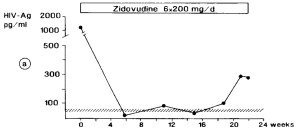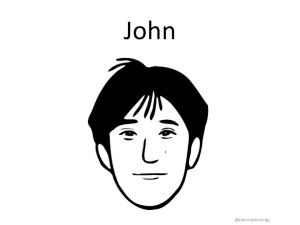[I accidentally published an earlier version of this post on August 23rd]
Even though I am Dutch and I work on HIV, I knew almost nothing about Joep Lange when he died a couple of weeks ago in the M17 flight.
For me, his name was mainly associated with one of his early papers, where he was not even the first author (Reiss, Lange et al 1988, Lancet). I frequently used a figure from that paper in my presentations (see below). The short paper, published in the Lancet in 1988, shows very clearly that the HIV drug AZT works initially, but after a few months HIV levels increase again. Later it became clear that this happens because HIV becomes resistant to AZT, which I am sure the authors suspected, but the word resistance doesn’t occur in the paper. The paper is important because it is one of the first that used quantification of HIV load to study treatment response. It also shows that world-class and important HIV research was coming out of the Amsterdam Medical Center.
Later, of course, in the 1990s, it was discovered that combining three drugs in a “cocktail” was a good way to reduce the probability that resistance evolved in HIV. This discovery marked a turning point in the HIV/AIDS epidemic, and Joep Lange was involved in it too.

Figure 1A of Reiss, Lange et al, 1988: Serum HIV antigen levels in two AIDS patients on zidovudine.
After the M17 crash, Joep Lange’s name was mentioned very often and I became curious to learn a little more about him. It turns out that he had done quite a few interviews for Dutch radio. I listened to two interviews which he gave in 2013 on Dutch public radio, and very much enjoyed them. Three things I found most interesting to learn:
1. Joep Lange was a very successful scientist, but when asked about his career, he explained that he owed a lot to luck. For example, he was a young specialist in internal medicine, with an interest for infectious disease in the Amsterdam Medical Center (AMC) right when in 1982 the first cases of HIV/AIDS occurred in Amsterdam, so just by being in the right place at the right time, he could start a career working on HIV/AIDS.
2. I am slightly embarrassed to say that I had no idea – but learned from the radio interviews – that Joep Lange, and not David Ho, was the first to suggest that triple-drug cocktails (later called HAART, highly active anti-retroviral therapy, or simply combination therapy) would be the key to preventing the evolution of drug resistance in HIV and therefore sustained treatment success.
3. Joep Lange, like many others, was wrong about the “Mississippi baby” who was thought to be cured of HIV, but now turns out to still be HIV positive.
In the interviews, Lange talks about four people who were thought to be cured: the “Berlin patient” (he got a bone marrow transplant from an HIV-resistant donor and is still considered cured), the “Mississippi baby” (who was given treatment from a few hours after birth, and seemed HIV negative for quite a while, but is now known to be HIV positive), and two patients in Boston (they got a bone marrow transplant and were negative for a while, but now turn out to be positive).
Tags: AMC, Amsterdam, AZT, combination therapy, drug resistance, HAART, HIV, Joep Lange, M17




